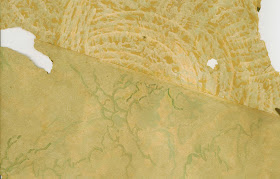I've got problem wallpaper in my 1970s house. The paper itself is in excellent condition, but I hate the pattern. Now I've found out it was applied directly to the drywall, making it short of impossible to remove the stuff without damaging the paper covering on the sheetrock. After much googling and youtube viewing and weighing the pros and cons of different methods, I've decided to leave the wallpaper where it is and cover it with two coats of Zinsser's primer/sealer
Gardz . I would have used this stuff anyway after removing the wallpaper, to be sure any paste left behind got sealed, so it's not an added expense. I've read examples of folks doing this with good results, so I'm hopeful it'll work.
Meanwhile I got to thinking about the problem wallpaper in the last house I lived in. It was an 1890 farmhouse that had been subject to a number of atrocities including the two examples of GahDawful wallpaper that appear at the top of this post. There was wallpaper upon wallpaper. In one case it was pasted to a fabric that looks like muslin. In another case it was pasted to a burlap bag from an Oklahoma flour mill. In other cases it was pasted to newspapers (we found pages dated 1929 and 1933). All this was pasted to a cardboard wall about double the thickness of cereal box material. There were silverfish everywhere. I saved samples of almost everything (not the silverfish) to help document the history of the house. Later I learned the owner from 1929 to 1995 was a painter and wallpaper hanger by profession. I'm not sure his methods could be considered "best practice", however.
How quickly the mind blocks out those old renovation horrors. My latest wallpaper "problem" suddenly pales in comparison.
 |
wallpaper pasted over wallpaper
|
 |
beige on beige, discolored with age
|
 |
Primordial dry wall? The alligatored surface faced in to the room.
|
 |
Broncho Bill comic from the old Dallas Journal circa 1929-33
|
 |
Muslin backer with more wallpaper.
|
 |
"Us Silverfish just love that wheat paste!"
|









No comments:
Post a Comment
Note: Only a member of this blog may post a comment.